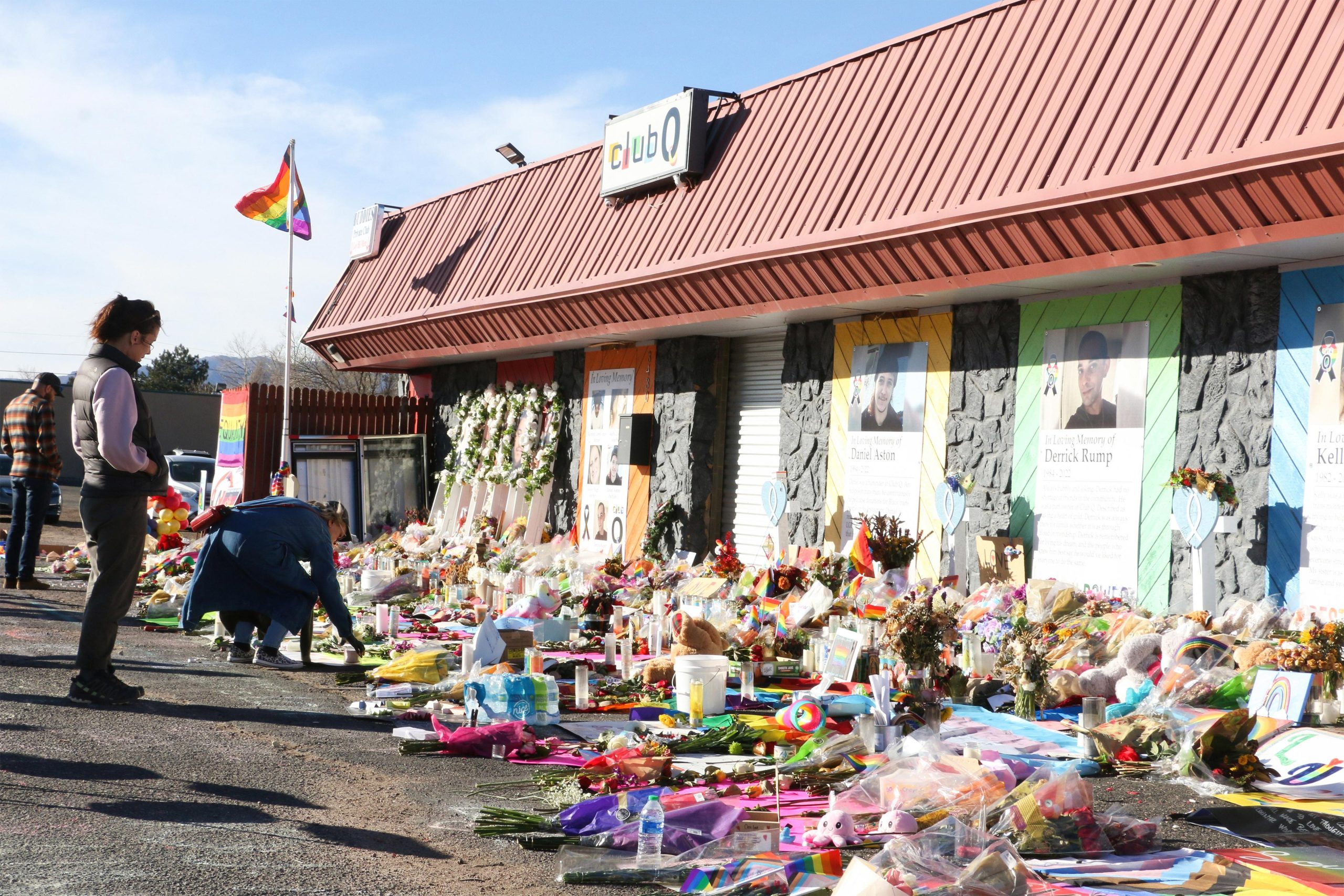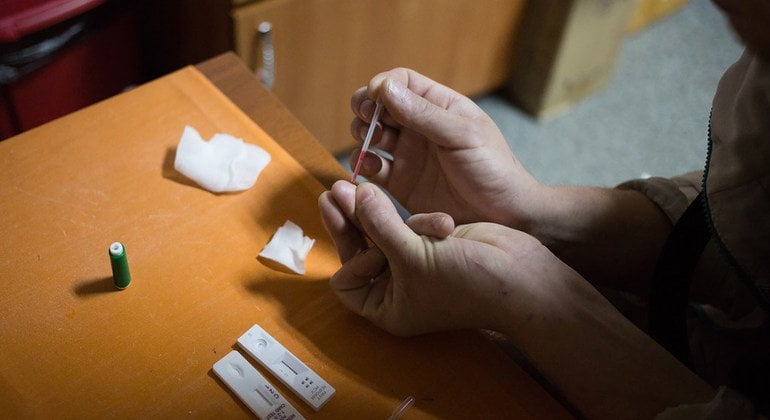A Nov. 19 shooting that killed five people and wounded 19 at a Colorado Springs nightclub has officials considering changes to strengthen Colorado’s red flag law, particularly in self-declared “Second Amendment sanctuaries,” where emergency petitions to remove a person’s guns are filed less frequently and usually denied.
The three-year-old state law allows law enforcement officials or family members to seek a court order to seize the guns of a person who poses a threat to themselves or others. But the Club Q shooting underscores a fundamental challenge for it and other red flag laws: Sheriffs often refuse to use the measures based on a belief that they infringe on the Second Amendment’s right to bear arms.
El Paso County, where the Colorado Springs shooting happened, is one such place. It has the lowest approval rate for initial court petitions filed under the law of any county in Colorado where more than three cases have been filed, according to a KHN analysis of court records. Now Colorado lawmakers, like those in other states that have experienced mass shootings in recent years, will try to turn angst over the incident into legislative action to strengthen the state’s red flag law, including potentially expanding the pool of people who can petition for a protection order.
Soon after the arrest of Anderson Lee Aldrich, the man accused of the Club Q shooting, reports surfaced of a previous incident in which he surrendered to police after threatening to blow up his mother’s home with a homemade bomb.
According to The Associated Press, court transcripts show that the judge who dismissed the case said in a hearing that the defendant had been stockpiling weapons and explosives, was “clearly” planning a shootout, and that he needed mental health treatment. Neither the family nor law enforcement sought an extreme risk protection order to ensure Aldrich didn’t have access to guns, leading to questions about whether November’s shooting could have been prevented if they had.
Colorado’s red flag law, passed in 2019, has been used more than 350 times, with initial petitions for protection orders being granted in nearly 2 in 3 cases.
Judges in El Paso County approved 11 out of 53 initial petitions, just over 20%, through Nov. 22. Although El Paso County is the most populous county in Colorado, about twice as many petitions were filed in Denver County, the next largest. There, judges approved 91 of 104 initial petitions, or nearly 88%.
Violence prevention advocates attributed El Paso County’s low approval rate to several factors. Among them, the county declared itself a Second Amendment sanctuary county in opposition to the red flag law, and El Paso County Sheriff Bill Elder has been adamant sheriff’s officials won’t seek any protection orders, “unless exigent circumstances exist.”
So far, the only two petitions filed by law enforcement in the county were sought by the Colorado Springs Police Department.
Analyses of red flag laws across the country show law enforcement officials are much more successful when they file petitions than when relatives or roommates of the person in question do.
“The ones that are petitioned for by law enforcement were approved more than 90% of the time, whereas the ones that are petitioned by family members, cohabitants, or parents were approved less than a third of the time,” said Dr. Chris Knoepke, a gun safety researcher with the University of Colorado’s Firearm Injury Prevention Initiative.
It’s unclear why law enforcement’s batting average is higher. It may be that police are more familiar with the legal requirements for processing and don’t make simple mistakes that can sink a petition. Law enforcement may also have easier access to legal help in filing, and judges may consider law enforcement officials more credible than family members.
Second Amendment sanctuary declarations by county governments or sheriffs can also have a chilling effect on petitions if laypeople misconstrue the largely symbolic gesture as preventing them from seeking a protection order.
The El Paso County Sheriff’s Office was widely criticized for not seeking a protection order after the Club Q suspect had been arrested and his guns seized in June 2021 after threatening to blow up his mother’s home. The sheriff’s office issued a statement in December saying the suspect’s weapons had already been seized and a mandatory protection order was in place, preventing him from buying additional firearms.
However, the charges against him were dismissed in July 2022, removing the mandatory protection order. The case records were sealed, which sheriff’s officials said prevented them from using that incident to pursue an extreme risk protection order. And no new evidence was available that would have allowed the sheriff to seek one, officials added.
Colorado Gov. Jared Polis, a Democrat, said his administration will look into why petitions were not filed in Colorado Springs and ways to strengthen the red flag law.
“We’re having a discussion now with local law enforcement, with state legislators about what holes exist in extreme risk protection orders and how we can better make sure that we have a system that works to keep people safe across Colorado,” the governor said.
Polis has floated the idea of expanding the group of eligible petitioners and has mentioned district attorneys as another potential category.
Nineteen states and the District of Columbia have red flag laws on their books, allowing different parties to petition for protection orders. Law enforcement officers file most red flag law petitions, although the lines between filing groups are often blurred. Family members or others with the ability to petition often ask police to file on their behalf, and some police departments urge relatives to let police handle the petition because they’re better at it.
Four states and the District of Columbia also allow health providers to petition. But those still represent a sliver of the total petitions filed.
“Health providers see this as a tool that can help their patients, but they don’t have the time to do it,” said Lisa Geller, director of state affairs at Johns Hopkins University’s Center for Gun Violence Solutions.
Maryland is hiring navigators to help health providers petition for protection orders, without having to go to court themselves. That kind of assistance could help other petitioners improve their chances of getting a protection order granted.
“When petitioners for domestic violence restraining orders have lawyers, their petitions for restraining orders are more likely to be granted,” said April Zeoli, an associate professor with the Institute for Firearm Injury Prevention at the University of Michigan. “These legal forms are not something that the general public is used to filling out.”
Geller said advocates are pushing states to use money available through the Bipartisan Safer Communities Act to increase education about red flag laws, both to make more people aware of the tool and to help law enforcement or other eligible petitioners learn how to seek them.
Colorado can access $4.6 million in funding for the 2022 and 2023 fiscal years and must apply for funds this month.
Florida passed its law after the 2018 Parkland high school shooting, and New York and Illinois expanded their laws after mass shootings in Buffalo and Highland Park, respectively. New York Democratic Gov. Kathy Hochul directed state police to expand the use of protection orders and created staff positions to make that happen. According to the governor’s office, 832 temporary and final extreme risk protection orders were issued in New York state in the three months after Hochul’s directive, compared with 1,424 issued from August 2019 to April 2022.
Colorado gun violence prevention advocates expect state legislators to push for tougher gun laws in the upcoming legislative session. Democrats held a slim majority in 2019 when they passed the bill establishing the red flag law, limiting its scope. But a landslide victory by Colorado Democrats in 2022 could provide the votes to offer more sweeping gun measures, such as a red flag law expansion, a semiautomatic weapons ban, or a raise in the minimum age for purchasing guns to 21.
“There was an appetite for this, anyways, before the Springs shooting,” said Eileen McCarron, president of gun violence prevention group Colorado Ceasefire Legislative Action. “But I think that shooting has exacerbated the issue, giving it more momentum.”
KHN (Kaiser Health News) is a national newsroom that produces in-depth journalism about health issues. Together with Policy Analysis and Polling, KHN is one of the three major operating programs at KFF (Kaiser Family Foundation). KFF is an endowed nonprofit organization providing information on health issues to the nation.
USE OUR CONTENT
This story can be republished for free (details).




